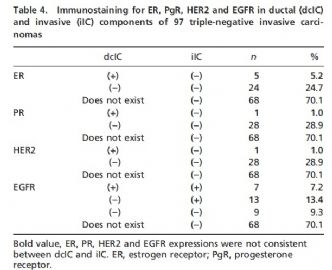| 图片: | |
|---|---|
| 名称: | |
| 描述: | |
- 观察细致
| 姓 名: | ××× | 性别: | 年龄: | ||
| 标本名称: | |||||
| 简要病史: | |||||
| 肉眼检查: | |||||
(Cancer Sci 2011; 102: 656–662)
To reveal heterogeneous properties of triple-negative (TN) breast
cancers (estrogen receptor negative, progesterone receptor negative
and HER2 negative) and to clarify whether the developmental
pathways to TN breast cancer are single or multiple, we conducted
clinicopathological and immunohistochemical studies on TN breast
cancers, with special reference to comparison of the invasive component
(iIC) and the ductal component (dcIC) of invasive TN breast
cancer and pure TN ductal carcinoma in situ (TNDCIS). Tumor tissues
were obtained from 97 patients with TN invasive carcinoma
and 10 patients with TNDCIS. Two histological subclassifications,
‘‘atypical’’ medullary carcinoma (type A, n = 16) and carcinoma
with a central acellular zone (type B, n = 11), were distinguished
from conventional ductal carcinoma. Other invasive ductal carcinomas
were classified as type C (n = 64) and special types were classified
as type D (n = 5). The follow-up period for the 96 patients
ranged from 5 to 147.8 months (mean, 47.6 months). Out of 97
cases, dcIC was present in 29 (30%) cases and type A and B had significantly
few ductal components, 0% and 18%, respectively.
There were only six (6%) cases with non-TN cells in dcIC and TN
cells in iIC and five of them were type C. In 13 (13%) cases, epidermal
growth factor receptor (EGFR) expression existed only in iIC.
Therefore, most of the TN carcinoma develops originally and
rapidly invades at the early stage, especially in types A and B. The
relapse rate of type B was the highest (36.4%) and the overall
survival of patients with type B was the shortest (P = 0.02), which
indicates that the prognosis of type B is significantly worse than
the other types.
标签:
×参考诊断















